How to Stand Up Paddle Board – the first part of our complete Paddle Board Technique Guide.
Find out the most important things you need to know as a beginner about SUP Paddle Technique.
In this article, we show you everything about correct paddle usage in SUP:
- How does one hold the paddle correctly, and what is the correct paddling position for stand-up paddle boarding?
- How do you determine the right Paddle Length?
- What are the actual Standing Positions on the SUP board?
- What is the correct hand and arm posture?
Plus, don’t miss the extra tip. We’ll show you how to avoid falling.
Do not miss to have a look at our full SUP Technique Guide. In part 2, for instance, we show you how to get up on a Stand Up Paddle Board.

In this first part, we focus on the basics of the Paddle Board Technique you will need to know as a beginner, and we’ll give you the most essential tips.
If you are looking for other information and tips on Stand Up Paddle Boarding, take a look at our full Paddle Board Technique rubric. There is a good chance that you will find a good guide to your question.
In our stand up paddle instructions, we assume that you own or rent the required material. If not, check out our overview of SUP boards and the Buyer Guide!
As always, the “Safety Disclaimer” applies: stand up paddling is a water sport! You should, therefore, always adhere to the most critical safety rules. If you do not know them yet, check them out quickly here.
The basic tips for a good paddle board technique.
Paddle position: How to hold the SUP paddle correctly
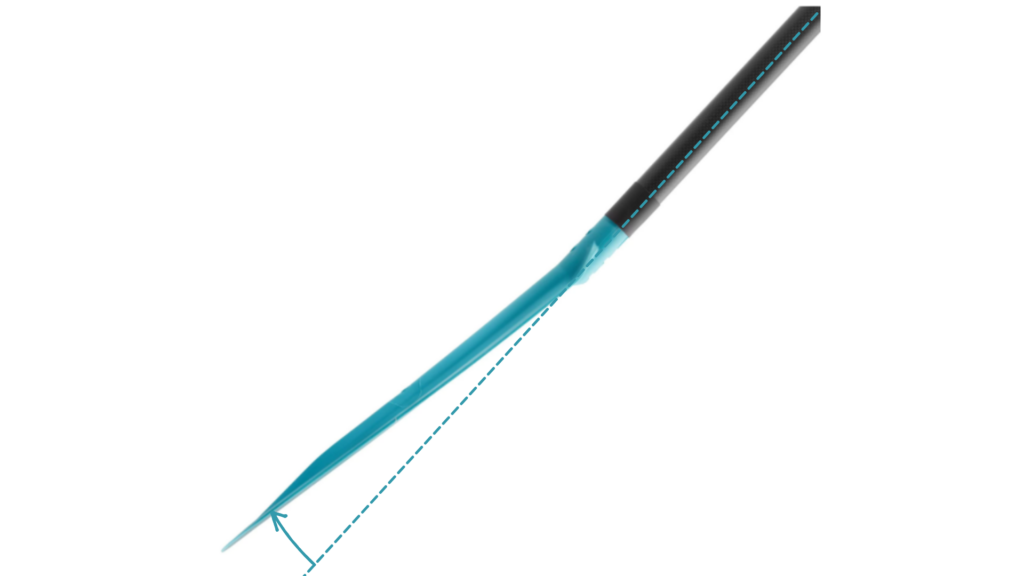
The paddle blade is angled by 10° – 13° degrees in relation to the shaft [1].
It is important to hold the paddle in such a way that the angle between the blade and the shaft is in the direction of travel.
The curve and position of the paddle increase the pulling distance and, thus its efficiency.
The extension of the paddle stroke seems exaggerated at first glance, but if you calculate the increase in the length of the paddle stroke on a longer distance, you can well imagine how many strokes and, thus, how much power can be saved.
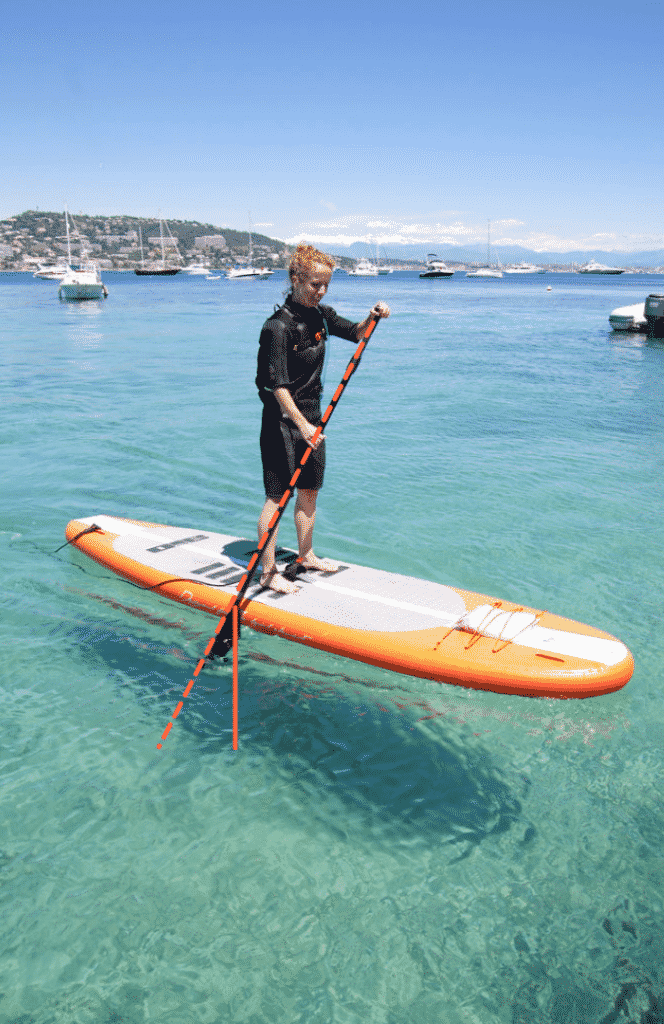
Another advantage of this paddle position becomes clear at the end of the paddle stroke [2].
This usually ends at the height of the feet of the standing position. Thanks to the angle between the paddle shaft and the paddle blade, the blade is approximately perpendicular to the water surface in this position.
If the paddle were held differently or if it were not bent, the blade would already “aim” towards the water surface, which would slow down propulsion.
SUP Paddle length: How to determine the right length for your paddle
The length of the paddle is just as important as, for instance, the length of a ski or the size of a bicycle frame.
From our point of view, the most straightforward measurement or adjustment method is as follows:
- Place the paddle upright with the handle on the floor.
- In a Race SUP Paddle, the transition from shaft to paddle should be approximately at eye level.
- A Wave SUP Paddle is usually about 5 to 10 cm or 2 to 4 inches shorter.
- A SUP Paddle for beginners is about 10 to 15 cm or 4 to 6 inches shorter.
In general, we recommend a Vario paddle for beginners, i.e., a paddle adjustable in length so that you can set the correct length yourself after a few strokes.
Key takeaways for paddle position, paddle length and paddle posture
Here, you can find a summarized and straightforward overview of what you should know and remember regarding paddle position and posture.
Holding the paddle
The paddle must be held in such a way that the angle between the blade and the shaft always points in the direction of travel
Paddle Length
Race paddle:
The transition between shaft and blade should be approximately at eye level.
Wave paddle:
It should be about 5 – 10 cm shorter
Beginner paddle:
About 10 – 15 cm shorter
Type of Paddle
For beginners, it is worth purchasing a Vario paddle, which allows you to experiment with the length until you have found the ideal size for you.
Standing position: How do you actually stand on the SUP board properly?
You should be familiar with the following stances for Stand Up Paddling
- The parallel stance
- The staggered stance
- The surf stance
It is important that you stand in the area of the so-called sweet spot (i.e., the center of gravity of the SUP board) and squatting slightly, in all stances.
This helps you keep the board in a good sliding position and keep your balance, even with small waves. Advanced Stand Up Paddlers also learn to stand in front of or behind the sweet spot depending on the situation and thus control the sliding position (e.g., to sprint or ride a wave).
As a beginner, however, you should definitely make sure that you are not standing too far forward or to the rear, so that neither stern nor bow lifts out of the water.
But how do the different stances work?
The Parallel Stance

The parallel stance is the basic position on the SUP board [3].
Your legs should be about shoulder-width apart at the sweet spot. This parallel stance at the sweet spot, especially when starting, is the position to stay in when going straight ahead.
How do I find out where the sweet spot is on my board?
It’s simple: the sweet spot of the board is the centre of gravity, i.e., roughly where the stand up paddle board can be balanced. Usually, this can be found near the handles.
The reason is just as apparent:
The handles are usually mounted there so that the board is easy to carry and is balanced “in itself” when taken. A typical all-round board or an entry-level board usually has enough capacity and width in the area of the sweet spot so the board can be easily controlled and stabilized.
The Staggered or Step Stance
The parallel stance can feel uncomfortable, especially during longer journeys. Often, this is due to the lower dynamic position of your feet.
If this is the case, you can switch to the so-called Staggered or Step Stance [4]:
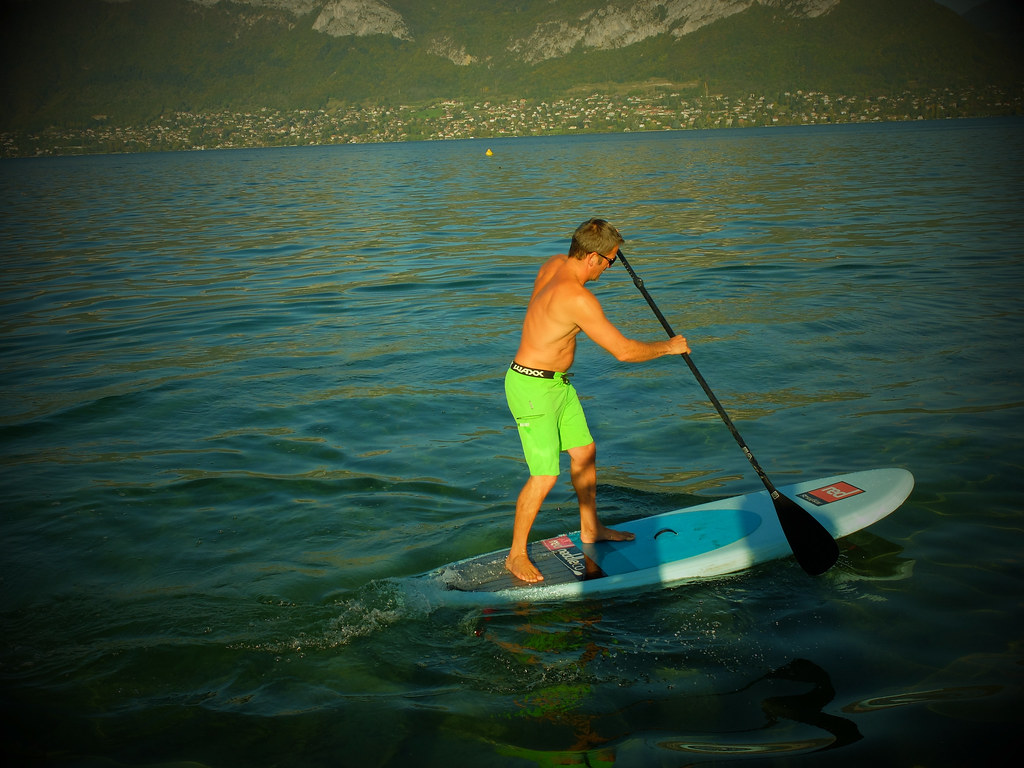
To do this, you shift from the parallel stance into an easy stepping position. One foot is positioned slightly in front of the sweet spot, and the other foot is somewhat behind the sweet spot.
The rear foot needs to be on the side on which you’re actually paddling, and the tips of your feet should point slightly towards the paddle.
Consequently, when you switch the side on which you paddle, you have to shift your stance accordingly. This gives you an easier dynamic in your legs and does not keep them in the same position for too long.
The Surf Stance
That is definitely the goal, but why should the surf stance [5] be important for a beginner?

The following can be said about that:
stand up paddling in shallow water is relatively easy to learn.
It is, therefore, often surprising how quickly even beginners try out manoeuvres when bare paddling.
When negotiating a fast curve or dynamically circumnavigating a buoy, steering becomes a lot easier with the surf stance.
Unlike the parallel stance, where the feet point in the direction of travel, the surf stance is about 90° to the direction of travel.
In the end, just like wave surfers do it.
Either the left foot is in front (so-called natural or regular stance) or the right foot (so-called goofy stance).
Which foot should be in front is purely based on individual preference. You can determine this quickly as follows:
Stand loosely in a parallel stance and let yourself be pushed lightly from behind without warning. You will find that you always instinctively catch yourself with the same foot. This is also the foot, which will typically be in front of the surf stance. In the surf stance, you stand a little more than shoulder-width with the “strong” foot in the middle of the board. This position then allows you to control the board with slight weight shifts, similar to snowboarding or skateboarding.
Key Takeaways for Stand Positions on a SUP Board
Here, you will find a summarized and straightforward overview of what you should pay attention to regarding stances on your next Stand Up Paddling tours.
Parallel Stance
Basic position. You stand at about shoulder width at the sweet spot, and your feet are aligned in the direction of travel.
Staggered Stance
The more dynamic position than the Parallel Stance is also suitable for going straight ahead.
One foot is slightly in front, one slightly behind the sweet spot, and the other point towards the paddle side.
Surf Stance
The surf stances are used with widening waves and also for dynamic manoeuvres. The natural stance has the left foot in front and a goofy stance on the right.
Important for all SUP Standing Positions
The knees are slightly bent, and the upper body is upright in all stances.
Hand and arm posture and grip
One of the most essential things about handling the paddle is that you hold it as loosely as possible and with relaxed wrists.
No more grip force should be used than to avoid losing control of the paddle. However, a cramped posture is definitely not necessary.
In most SUP paddling techniques, the arms are stretched out [6]. The stretched arm position allows you to work with the stronger core muscles instead of the smaller muscle groups of the arms and shoulders.
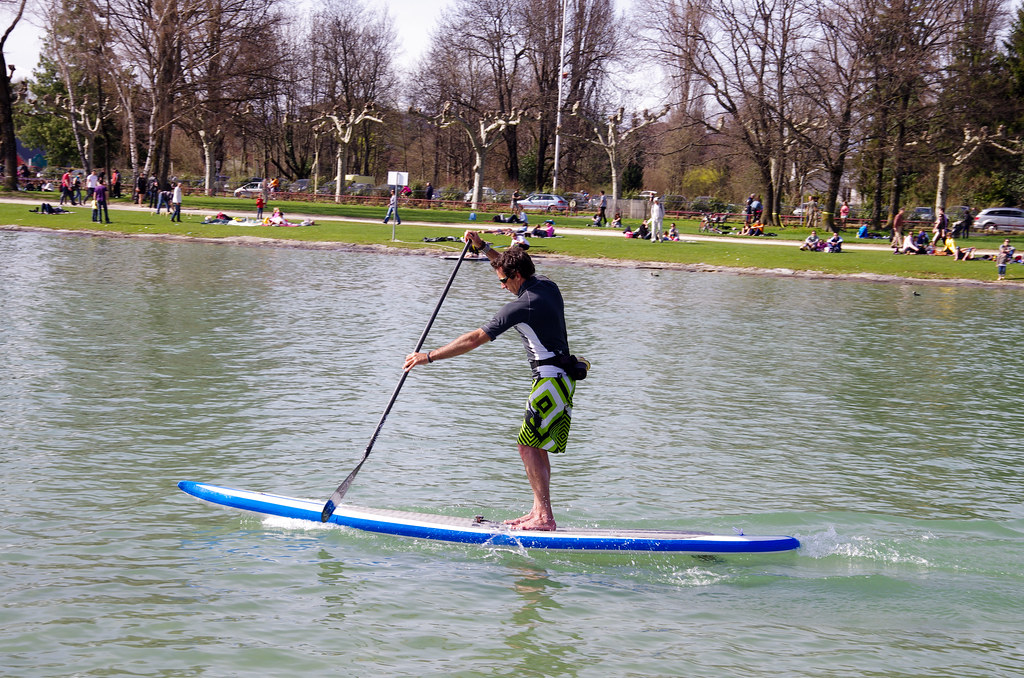
Equally important for a correct paddle stroke is optimal grip width. You can determine the proper grip width easily using the “box trick.”
The paddle is held horizontally over the head and forms a 90° angle with the lower and upper arms so that a rectangle forms between the paddle and the arms. The position of the hands on the paddle now corresponds approximately to the optimal grip range.
Finally, it is essential for you to vary the position of the shaft hand (i.e., the lower hand) until you feel comfortable. In particular, care must be taken not to tighten up, as this will make your power stroke more difficult.
Key Takeaways on how to hold the SUP Paddle
Again, below is a quick and clear summary of how you should grip the SUP paddle and what you have to pay attention to so that you do not lose power.
Where you hold the paddle…
Always hold the paddle with one hand on the handle and one on the shaft
How firmly you have to hold the paddle…
Hold the paddle loosely and with relaxed wrists. The lower hand should grip more firmly only with stronger strokes.
Where does the strength come from…
Strength comes from the torso and not mainly from the upper arms and shoulders. Thus, the arms are stretched out, and the upper body is upright in SUP.
What you should avoid…
Do not grip the paddle too tightly, as this will reduce the power of your stroke.
And now, as promised, one of our bonus tips is included in our SUP paddling technique guide.
Bonus – SUP – Tip: Paddle support, or how to avoid falls
A good tip, especially for beginners, is, “If you are in trouble, then paddle into the water!”
Even if you are already severely in trouble, you can easily take advantage of water resistance.
Press the flat of the paddle blade (whether front or back does not matter) into the water:
This allows you to support yourself on the paddle for a short time and save yourself from falling. Falling into the water is anything but bad, and on hot days, it is even reviving. However, it is also a good experience if you can avoid falling at the beginning with paddle support.
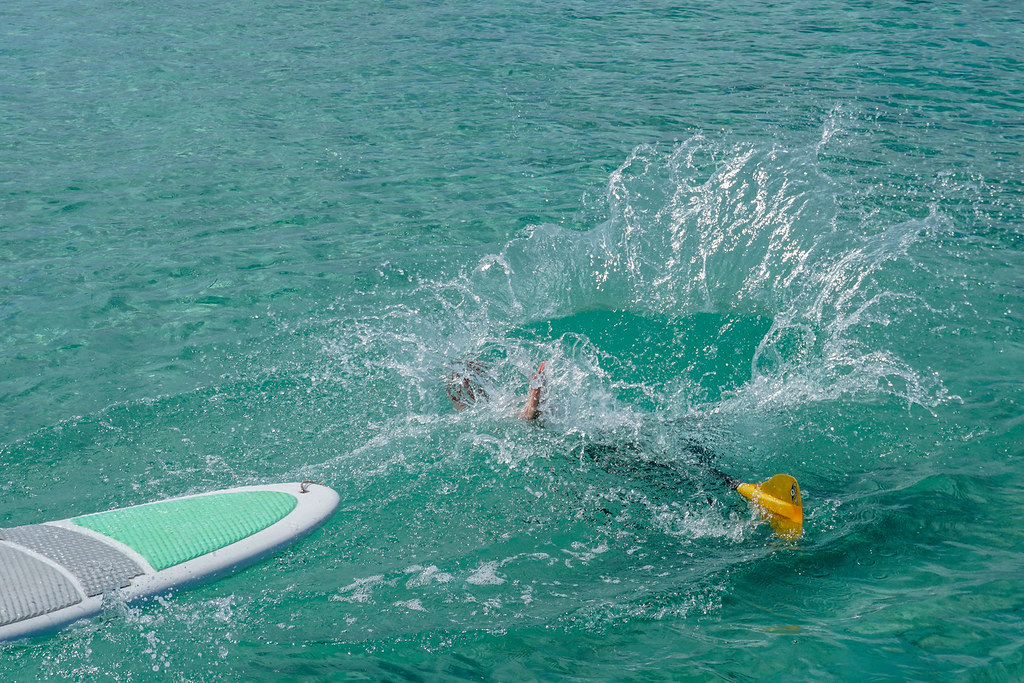
How To Stand Up Paddle Board: Where you can find more about paddle board technique
We hope that this overview of the basics of SUP technology will help you with your first excursions on the water.
And remember: Practice is key and even fun with SUP!
So off to the water and get wet! If you still want to know more about How to Paddle Board and SUP paddle techniques, take a deeper look at the other tips in our SUP guide.






